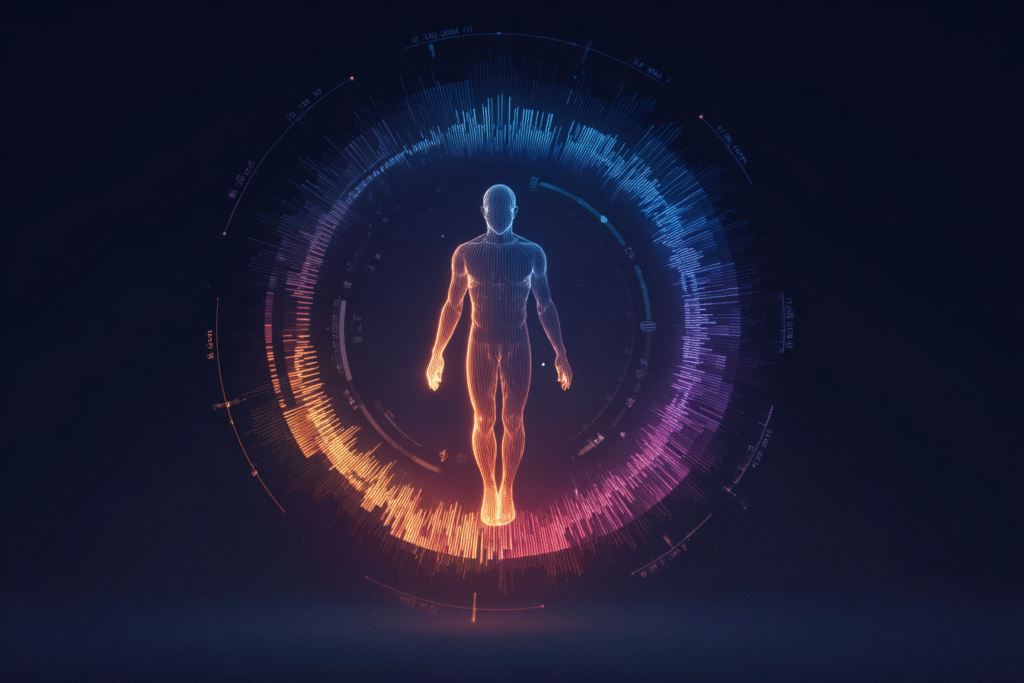The most profound health insights often arrive through a subtle knowing that emerges from deep within.
Note: This article is for educational and informational purposes only. See full disclaimer at the end.
In our age of endless health apps, continuous glucose monitors, and sleep tracking devices, we’ve never had more information about our bodies.
Yet many of us feel more disconnected from our physical selves than ever before. We’ve learned to trust screens over sensations, algorithms over intuition, and external validation over internal wisdom.
This creates a peculiar modern dilemma: we know more about our health metrics than any generation in history, yet we often struggle to make confident decisions about our wellbeing.
We second-guess our body’s signals, overthink every symptom, and find ourselves trapped in cycles of health anxiety precisely when we should feel most empowered.
The solution isn’t abandoning our monitoring tools or dismissing the value of health data. Instead, it’s developing what researchers are increasingly recognizing as a crucial but overlooked health competency: health intuition.

What Health Intuition Actually Is
Health intuition isn’t mystical thinking or wishful delusion. It’s a sophisticated integration of multiple information streams that your body and brain process continuously but often below conscious awareness. Recent neuroscience research reveals that what we call “gut feelings” about our health involve complex neural networks, particularly the insula and interoceptive systems, that monitor internal bodily states [1].
Dr. Antonio Damasio’s landmark research on somatic markers demonstrates that our bodies generate subtle physiological signals that guide decision-making long before conscious thought kicks in [9]. In health contexts, this translates to an embodied intelligence that can detect patterns, predict needs, and guide healing responses with remarkable accuracy.
Medical professionals have long recognized the clinical value of intuition. Studies show that experienced physicians rely heavily on “gut feelings” that prove correct 93% of the time, even when contradicting objective data [2]. Emergency room doctors describe a “sixth sense” that alerts them to patients who need immediate attention despite normal vital signs.
These aren’t mystical powers—they’re the result of highly tuned, experience-based perception.
What makes health intuition particularly powerful is its integration of multiple sensing systems. Your interoceptive network monitors heart rate variability, digestive rhythms, hormonal fluctuations, immune responses, and countless other internal processes [3]. Your proprioceptive system tracks movement quality, tension patterns, and postural changes. Your emotional processing centers recognize the psychological components of physical symptoms. Your pattern recognition capabilities, honed by years of living in your body, detect subtle deviations from your personal baseline.
Health intuition synthesizes all of this into what researchers call “embodied cognition”—a form of intelligence that emerges from the dynamic relationship between mind, body, and environment [4].
Understanding health intuition conceptually is one thing—developing it systematically is another. Cultivating this capacity involves four interconnected dimensions that work together to create sophisticated health intelligence.

The Four Dimensions of Health Intuition
Developing health intuition involves cultivating four interconnected capacities that work together to create sophisticated health intelligence:
1. Somatic Awareness: Reading Internal Signals
The foundation of health intuition is enhanced interoceptive accuracy—the ability to consciously perceive internal bodily signals. Research shows that individuals with higher interoceptive sensitivity make better health decisions, experience less anxiety about symptoms, and demonstrate superior emotional regulation [5].
This isn’t about becoming hypervigilant or anxiously monitoring every sensation. Instead, it’s developing what researchers call “adaptive interoception”—a calm, curious awareness that can distinguish between signals that require attention and normal bodily fluctuations [6].
Practical somatic awareness involves learning to recognize your body’s unique vocabulary. Stress might show up in your digestion as knots, bloating, or tightness. Your cardiovascular system might indicate recovery needs through subtle energy shifts. Your musculoskeletal system might communicate overuse through particular movement restrictions.
The key is developing sensitivity without reactivity—the ability to notice and assess without immediately catastrophizing or dismissing.
2. Pattern Recognition: Understanding Your Health Rhythms
Your body operates within complex rhythms and patterns that extend far beyond basic circadian cycles. Health intuition involves recognizing these personal patterns and understanding how they interact with lifestyle, environmental, and psychological factors.
Some people naturally feel energized in the morning and wind down in the evening. Others experience peak alertness in late afternoon. Some thrive on consistent routines while others need variety to maintain optimal health. Some recover quickly from physical stress while others require extended restoration periods.
Health intuition means recognizing not just what your patterns are, but how they shift with circumstances. You might notice that your sleep needs increase during stress, that certain foods affect your mood differently depending on the season. Or that your exercise tolerance varies with hormonal cycles.
Advanced pattern recognition includes understanding how systems interact—like how digestive trouble can precede mood shifts, or how sleep quality affects pain sensitivity and emotional resilience.

3. Contextual Integration: Holistic Health Assessment
Health intuition excels at what medical systems often struggle with: seeing the whole person within their complete life context. While diagnostic approaches typically isolate symptoms and seek linear cause-and-effect relationships, intuitive health assessment recognizes the complex, multi-dimensional nature of wellbeing.
This dimension involves understanding how physical symptoms relate to emotional states, life circumstances, relationship dynamics, work stress, seasonal changes, and developmental transitions. A headache might signal dehydration, eye strain, muscle tension, hormonal fluctuations, sleep debt, or emotional overwhelm—or some combination of multiple factors.
Contextual integration means developing the capacity to hold complexity without needing to immediately reduce it to simple explanations. It involves asking questions like: “What else is happening in my life right now?” “How might different stressors be interacting?” “What does this symptom pattern typically mean for me personally?”
This holistic perspective often reveals intervention opportunities that single-factor thinking misses. Instead of just treating a symptom, you might recognize the need to address sleep, stress, nutrition, movement, and emotional processing simultaneously.
4. Temporal Sensitivity: Knowing When and How Much
Perhaps the most sophisticated aspect of health intuition is what researchers call “temporal sensitivity”—the ability to sense timing, duration, and intensity in health decisions. This goes beyond knowing what to do to understanding when to do it, how long to continue, and when to change approaches.
Temporal sensitivity recognizes that the same intervention can have dramatically different effects depending on timing. Exercise might be energizing in the morning but disruptive in the evening. Certain foods might be nourishing during active periods but burdensome during rest phases. Social interaction might be healing during some emotional states but overwhelming during others.
For instance, you might discover that morning exercise energizes you while evening workouts leave you wired. Temporal sensitivity helps you recognize this isn’t simply about circadian rhythms—your body processes physical stress differently based on cortisol fluctuations, daily demands, and energy reserves. Rather than forcing a rigid schedule, you learn to adapt timing, intensity, and exercise type based on your body’s subtle temporal cues.
This dimension also involves recognizing the difference between acute responses and chronic patterns, and knowing which require urgent action versus patient observation.
Advanced temporal sensitivity includes understanding your personal healing rhythms—how long you typically need to recover from different types of stress, how quickly you respond to various interventions, and what your optimal cycles look like for work, rest, nutrition, and social connection.

From Anxiety to Intelligence
The journey from health anxiety to health intuition involves a fundamental shift in how you relate to uncertainty and physical sensations. Instead of interpreting every symptom as a potential threat, you develop the capacity to assess, understand, and respond appropriately.
This transformation typically unfolds through several stages:
Stage 1: Awareness Without Reactivity The first shift involves learning to notice physical sensations and health changes without immediately activating fight-or-flight responses. This requires developing what researchers call “metacognitive awareness”—the ability to observe your thoughts and reactions without being overwhelmed by them [7].
Stage 2: Curious Investigation Instead of instinctively turning to search engines or assuming worst-case scenarios, you develop the capacity for curious, gentle investigation. You learn to ask open-ended questions: “What is my body trying to communicate?” “What contextual factors might be relevant?” “What does my deeper knowing suggest?”
Stage 3: Pattern Integration You begin recognizing how current symptoms or sensations fit within your personal health patterns. You understand your unique responses to stress, your typical recovery processes, and your individual variations in normal functioning.
Stage 4: Confident Decision-Making You develop the ability to make appropriate health decisions based on integrated information from multiple sources—symptoms, patterns, context, and deep bodily knowing. You know when to rest, when to observe, when to act, and when to ask for help.
Stage 5: Fluid Responsiveness At the most advanced level, health intuition becomes a dynamic, responsive capacity that adapts fluidly to changing circumstances. You naturally adjust nutrition, movement, rest, and stress management based on subtle internal feedback systems.

Building Health Intuition
Developing health intuition is a learnable skill that improves with practice. Here are evidence-based approaches for cultivating this capacity:
Daily Interoceptive Practice
Begin each day with a brief internal body scan. Spend 3-5 minutes systematically noticing sensations throughout your body without trying to change anything. Notice energy levels, areas of tension or ease, digestive sensations, and overall felt sense.
Research shows that regular interoceptive training enhances body awareness, reduces anxiety, and improves decision-making [8]. The key is developing familiarity with your internal landscape during neutral moments so you can recognize deviations more accurately.
Symptom Journaling with Context
When you experience health symptoms or concerns, practice contextual documentation. Instead of just noting the symptom, record:
- What else was happening in your life at the time
- Your stress levels, sleep quality, and emotional state
- Recent changes in routine, diet, or circumstances
- Your initial intuitive sense about the symptom’s meaning
- How you chose to respond and what happened
Over time, this builds sophisticated pattern recognition and validates your intuitive assessments.
Decision Pause Practice
Before making any health-related decision—what to eat, whether to exercise, how to respond to a symptom—take a moment to check in with your deeper knowing.
Ask yourself: “What does my body actually want right now?” “What response feels most aligned?” “What would serve my health best in this moment?”
Initially, you might not trust these responses, but tracking their accuracy over time typically reveals surprising wisdom.
Energy and Rhythm Tracking
Pay attention to your natural energy across your days, weeks, and months. Notice when you feel most alert, creative, social, or introspective. Track how different activities, foods, and circumstances affect these rhythms.
This develops temporal sensitivity and helps you align lifestyle choices with your body’s natural preferences rather than fighting against them.

Integration with Modern Health Tools
Health intuition doesn’t replace modern medical care or health monitoring technology—it enhances them. When you develop sophisticated body awareness, you use diagnostic tests more effectively, communicate more clearly with healthcare providers, and make better decisions about when professional help is needed.
Your wearable devices become partners in pattern recognition rather than anxiety-producing taskmasters. Instead of obsessing over daily metrics, you learn to recognize meaningful trends and correlations. You might notice that your heart rate variability consistently drops before you consciously recognize stress, or that your sleep scores correlate with specific lifestyle factors in ways that weren’t obvious before.
The key is maintaining your internal authority while leveraging external information. Technology provides valuable data, but your embodied intelligence determines what that data means for your unique circumstances and health goals.
When Intuition Suggests Professional Care
A crucial aspect of health intuition is recognizing when symptoms or concerns exceed your self-care capacity. Developed health intelligence includes clear internal signals about when to seek professional evaluation.
These signals might include:
- Persistent symptoms that don’t respond to usual self-care approaches
- Sudden changes in established patterns without obvious cause
- A deep sense that “something isn’t right” even when symptoms seem minor
- Anxiety or concern that interferes with daily functioning
- Any situation where your intuitive sense suggests professional evaluation
It’s not overreaction—it’s responsible, informed self-awareness that recognizes the limits of self-assessment and the value of professional expertise.

The Ripple Effects of Health Intuition
As you develop health intuition, the benefits extend far beyond physical wellbeing. You make better decisions across all life domains because you’re more attuned to your authentic needs and responses. You experience less anxiety because you trust your ability to recognize and respond to health changes appropriately.
Your relationships improve because you’re better at recognizing when you need rest, social connection, or space. Your work performance enhances because you understand your natural rhythms and energy patterns. You feel more satisfied because you’re living in partnership with your body instead of fighting it.
Perhaps most importantly, you develop a more peaceful relationship with the uncertainty that’s inherent in having a human body. Instead of needing to control or predict every aspect of your health, you trust your capacity to respond wisely to whatever arises.
Health intuition transforms you from an anxious monitor of your body into a wise steward of your wellbeing—confident, responsive, and deeply connected to the intelligence that’s been guiding your healing all along.
See you in the next insight.
Comprehensive Medical Disclaimer: The insights, frameworks, and recommendations shared in this article are for educational and informational purposes only. They represent a synthesis of research, technology applications, and personal optimization strategies, not medical advice. Individual health needs vary significantly, and what works for one person may not be appropriate for another. Always consult with qualified healthcare professionals before making any significant changes to your lifestyle, nutrition, exercise routine, supplement regimen, or medical treatments. This content does not replace professional medical diagnosis, treatment, or care. If you have specific health concerns or conditions, seek guidance from licensed healthcare practitioners familiar with your individual circumstances.
References
The references below are organized by study type. Peer-reviewed research provides the primary evidence base, while systematic reviews synthesize findings across multiple studies for broader perspective.
Peer-Reviewed / Academic Sources
- [1] Mehling, W. E., Price, C., Daubenmier, J. J., Acree, M., Bartmess, E., & Stewart, A. (2012). The multidimensional assessment of interoceptive awareness (MAIA). PLoS One, 7(11), e48230. https://journals.plos.org/plosone/article?id=10.1371/journal.pone.0048230
- [2] Stolper, E., Van de Wiel, M., Van Royen, P., Van Bokhoven, M., Van der Weijden, T., & Dinant, G. J. (2011). Gut feelings as a third track in general practitioners’ diagnostic reasoning. Journal of General Internal Medicine, 26(2), 197-203. https://link.springer.com/article/10.1007/s11606-010-1524-5
- [3] Khalsa, S. S., Adolphs, R., Cameron, O. G., Critchley, H. D., Davenport, P. W., Feinstein, J. S., Feusner, J. D., Garfinkel, S. N., Lane, R. D., Mehling, W. E., Meuret, A. E., Nemeroff, C. B., Oppenheimer, S., Petzschner, F. H., Pollatos, O., Rhudy, J. L., Schramm, L. P., Simmons, W. K., Stein, M. B., Stephan, K. E., Van den Bergh, O., Van Diest, I., von Leupoldt, A., & Paulus, M. P. (2018). Interoception and mental health: a roadmap. Biological Psychiatry: Cognitive Neuroscience and Neuroimaging, 3(6), 501-513. https://www.sciencedirect.com/science/article/pii/S2451902217302343
- [4] Schmalzl, L., Powers, C., & Henje Blom, E. (2015). Neurophysiological and neurocognitive mechanisms underlying the effects of yoga-based practices: towards a comprehensive theoretical framework. Frontiers in Human Neuroscience, 9, 235. https://www.frontiersin.org/articles/10.3389/fnhum.2015.00235/full
- [5] Hanley, A. W., Mehling, W. E., & Garland, E. L. (2017). Holding the body in mind: interoceptive awareness, dispositional mindfulness and psychological well-being. Journal of Psychosomatic Research, 99, 13-20. https://pubmed.ncbi.nlm.nih.gov/28712417/
- [6] Mehling, W. E. (2016). Differentiating attention styles and regulatory aspects of self-reported interoceptive sensibility. Philosophical Transactions of the Royal Society B, 371(1708), 20160013. https://royalsocietypublishing.org/doi/10.1098/rstb.2016.0013
- [7] Farb, N. A., Segal, Z. V., & Anderson, A. K. (2013). Mindfulness meditation training alters cortical representations of interoceptive attention. Social Cognitive and Affective Neuroscience, 8(1), 15-26. https://academic.oup.com/scan/article/8/1/15/1656647
- [8] Fischer, D., Messner, M., & Pollatos, O. (2017). Improvement of interoceptive processes after an 8-week body scan intervention. Frontiers in Human Neuroscience, 11, 452. https://www.frontiersin.org/articles/10.3389/fnhum.2017.00452/full
Industry / Technology Sources
- [9] Damasio, A. (1994). Descartes’ error: Emotion, reason, and the human brain. Philosophical Psychology, 7(4), 413-420. https://www.amazon.com/Descartes-Error-Emotion-Reason-Human/dp/014303622X


